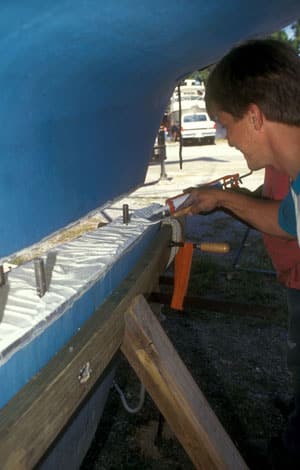
keel bolts
Most sailboats, or monohulls at least, rely on ballast to counter the forces of wind on the sails, so keeping a bolted-on keel connected to a hull is of the utmost importance.
“Keel bolts” is a catchall name for the fasteners used to fix external ballast in place. Most fin keels actually are retained using J-shaped studs that are cast into the keel and secured in the boat’s bilge with nuts. Because of their location and the stresses placed upon them, keel bolts—what you can see of them—should be inspected annually.
Keel fasteners run the gamut from mild carbon steel to bronze to stainless steel and such exotic shaft alloys as Aquamet. In the majority of installations, fasteners are made from stainless steel, which in turn is available in a variety of alloys. Ideally, the alloy used combines high corrosion resistance with sufficient tensile strength for the application. One such alloy is 316. Other stainless-steel alloys, such as 304 or 18-8, are significantly more prone to corrosion.
Without dropping the keel, the only portions of the keel fasteners that are visible are in the bilges. To inspect them, first make sure you can reach them all. The bilge should be clean and, of course, well lighted; start by drying it out completely so you can determine if the fasteners are leaking.
Anything other than minor rust or staining of the rods or nuts is cause for concern. The nuts should be removed from rusting fasteners, one at a time, and the threads of each inspected for signs of crevice corrosion. Deformed, pitted, or galled threads mean that a fastener is compromised. Options in this case are few. If the stud is long enough, its nut may be shimmed to move it to an area where the threads are unaffected. In a worst-case scenario, studs may have to be replaced, a substantial and costly undertaking.
Nuts should be replaced using a torque wrench and the standard torque values for the fastener’s alloy and diameter; if in doubt, use the lower applicable torque. Be sure there’s nothing between the keel-stud nut and the inside of the hull other than a washer or a load-distributing plate. Bonding straps and wire-ring terminals should be attached only above a nut.
Outside the boat, if rust is coming from the joint between the keel and the hull, it’s a sign that studs may have crevice corrosion where it can’t be seen or easily serviced, in the hull or stub. If there are signs of movement between the keel and hull or if there’s evidence of corrosion, either in the bilge or on the exterior, strong consideration should be given to pre-emptively dropping the keel. The life of keel fasteners can be extended by ensuring a watertight seal between the keel and the hull and by keeping the bilge as dry as possible. Coating keel fasteners with a corrosion inhibitor that won’t easily wash off—I like to use CRC Heavy-Duty Corrosion Inhibitor—represents an inexpensive investment in one of your boat’s most important components.
Steve’s Tip:
What stainless-steel alloy is used in your keel fasteners? Broadly speaking, if the fastener is magnetic or shows anything other than the most minor evidence of rust staining or bleeding, chances are that it isn’t 316 stainless steel but rather one of the less corrosion-resistant alloys. Keel fasteners that fall into the latter category warrant especially close attention and upkeep.
Steve D’Antonio offers services for boat owners and buyers through Steve D’Antonio Marine Consulting.








